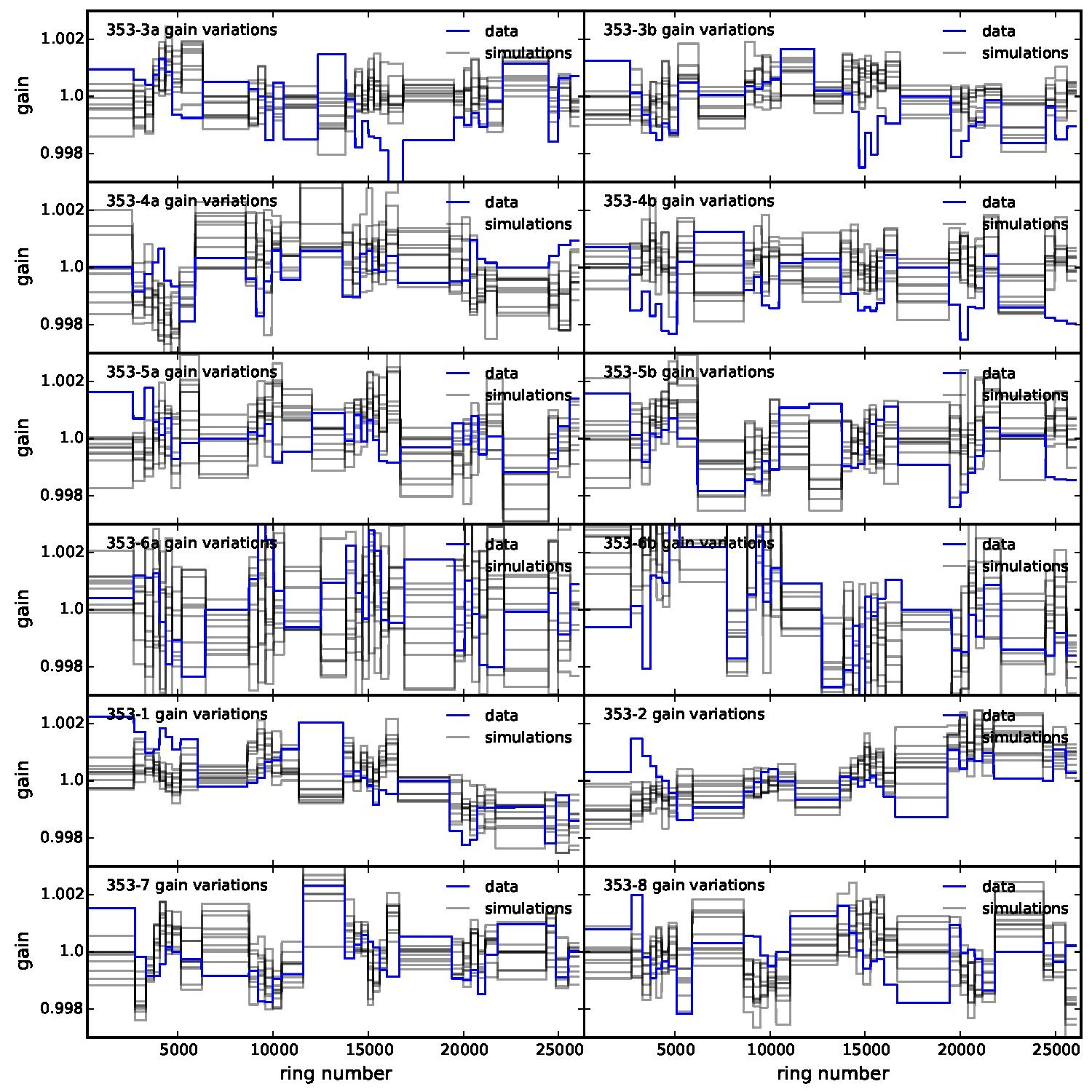Appendix of HFI DPC paper
This page is intented to provide complementary figures to those of the 2017 HFI DPC paper (Planck-2020-A3[1]).
Section 3.1.2: Very bright regions where the sub-pixel effect in the SRoll CO foreground templates prevent them to be used for cosmology or astrophysics analysis
The bandpass corrections have been optimized for high latitude regions which implied to reduce the noise of the CO and dust bandpass templates to avoid the introduction of significant correlated noise. The effect is negligible for dust but not for CO in bright regions. We simulated the effect to evaluate its level. The difference between the simulated downgraded (at Nside=128) CO simulated maps and the input full resolution (at Nside=2048) CO simulated maps gives the simulated bias introduced by this downgrading for each bolometer. For each frequency channel, these bias maps are converted to HPRs, multiplied by the corresponding CO bandpass coefficients computed by SRoll, and projected onto a frequency map of the bias for the channel. Those frequency averaged bias maps are displayed in the table and given in PLA (LVLV).
For convenience, we also provide the maps of the logarithm of the ratio of the variance, in each Nside=128 pixel, between the bias map and the noise level estimated from the End-to-End simulations. This bias is well determined and specific masks adapted to each scientific analysis can be computed at the appropriate level. Those bias maps are also provided in the PLA.
We also provide the ratio of the bias maps to the full intensity.
The table also gives the sky fraction to be masked for thresholding the bias at 100, 10, and 1 % the rms of the bias at Nside=2048 inside the pixel at Nside=128 referred to the rms of the noise at Nside=2048 inside the same pixel at Nside=128.
The effects are largest at 100 GHz. It can also be noted that, for polarization, only less than 10-3 of the sky is affected by this bias at the noise level. For intensity, the biais is an order of magnitude lower. If the user wants to reduce the bias below 10 % of the noise in polarization, 2% of the sky will be affected. Users can also refer to the absolute value of the bias with respect to the CO maps to build the relevant mask.
As recommended in DPC paper LVLV, Galactic science work with the HFI data in these very bright regions should be done with the specifically built maps from HPRs (LVLV) at the full resolution.
Section 5.3.10: for convenience, we reproduce here Figures 6, 7 and 8 of Rosset et al.
This paper is published as Rosset et al. Planck pre-launch status: High Frequency Instrument polarization calibration. 2010b, A&A, 520, A13. ([2]) The figures 6, 7 et 8 reproduced hereunder are given in the version on ArXiv 1004.2595
| gain errors (1) | polarization efficiency errors (2) | orientation errors (3) |
|---|---|---|
Error creating thumbnail: convert: unable to extend cache `/tmp/magick-32400F8fo72EFI2w2': File too large @ error/cache.c/OpenPixelCache/4091.
|
Error creating thumbnail: convert: unable to extend cache `/tmp/magick-32407UUrVo738dO8u': File too large @ error/cache.c/OpenPixelCache/4091.
|
Error creating thumbnail: convert: unable to extend cache `/tmp/magick-324148wuJRA9Z87vQ': File too large @ error/cache.c/OpenPixelCache/4091.
|
(1) in rms due to gain errors from 0.01% to 1% for E-mode (top) and B-mode (bottom) compared to initial spectrum (solid black lines). Cosmic variance for E-mode is plotted in dashed black line.
(2) in rms due to polarization efficiency errors from 0.1% to 4% for E-mode (top) and B-mode (bottom) compared to initial spectrum (solid black lines). Cosmic variance for E-mode is plotted in dashed black line.
(3) in rms due to various orientation errors from 0.25 to 2 degrees for E-mode (top) and B-mode (bottom) compared to initial spectrum (solid black lines). Cosmic variance for E-mode is plotted in dashed black line.
Section 5.5: complementary figures of Fig. 29
| 100 GHz bolometers | 143 GHz bolometers | 217 GHz bolometers | 353 GHz bolometers | ||||
|---|---|---|---|---|---|---|---|

|

|

|

|

|

|

|

|
| 100px | 
|

|

|

|

|

|

|

|

|

|

|

|

|

|

|

|

|

|

|

|

|

|

|

|

|

|

|

|

|

|

|

|

|

|

|

|

|

|

|

|

|

|

|

|

|

|

|

|

|

|

|

|

|

|

|
| . | . | 
|

|

|

|

|

|
| . | . | 
|

|

|

|

|

|
| . | . | 
|

|

|

|

|

|
| . | . | . | . | 
|

|

|

|
Section 5.13: complementary figures of Fig. 47
References[edit]
- ↑ Planck 2018 results. III. High Frequency Instrument data processing and frequency maps, Planck Collaboration, 2020, A&A, 641, A3.
- ↑
(Planck) High Frequency Instrument
Data Processing Center
Planck Legacy Archive
EMI/EMC influence of the 4K cooler mechanical motion on the bolometer readout electronics.
analog to digital converter












